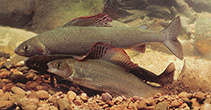Common names from other countries
分類 / Names 共通名の | 類義語 | Catalog of Fishes(部類, 種) | ITIS | CoL | WoRMS | Cloffa
> Salmoniformes (Salmons) > Salmonidae (Salmonids) > Thymallinae
Etymology: Thymallus: Greek, thymallos, -ou = a kind of fish similar to salmon (Ref. 45335); thymallus: The name 'thymallus' could come from the thyme taste of the flesh of this fish (Ref. 30578).
More on author: Linnaeus.
Etymology: Thymallus: Greek, thymallos, -ou = a kind of fish similar to salmon (Ref. 45335); thymallus: The name 'thymallus' could come from the thyme taste of the flesh of this fish (Ref. 30578).
More on author: Linnaeus.
Environment: milieu / climate zone / depth range / distribution range 生態学
; 新鮮な水; 汽水性の 底生の漂泳性; pH range: 7.0 - 7.5; dH range: 20 - ?; 移住性ではない; 深さの範囲 15 - ? m (Ref. 30578). Temperate; 6°C - 18°C (Ref. 2059); 70°N - 42°N, 6°W - 66°E
分布 国々 | 国連食糧農業機関の区域 | エコシステム | 事件 | Point map | 導入 | Faunafri
Europe: Barent Sea basin west of Urals, Caspian, Black, Baltic, White and North Sea basins, Atlantic westward to Loire drainage; Rhône drainage; northern Adriatic basin east to Soca drainage. Introduced over most of southern and central Finland.
Length at first maturity / サイズ / 重さ / 年齢
Maturity: Lm ? range ? - ? cm
Max length : 60.0 cm TL オス/雌雄の選別がない; (Ref. 556); common length : 30.0 cm TL オス/雌雄の選別がない; (Ref. 556); 最大公表体重: 6.7 kg (Ref. 6368); 最大記録サイズ: 14 年 (Ref. 556)
Max length : 60.0 cm TL オス/雌雄の選別がない; (Ref. 556); common length : 30.0 cm TL オス/雌雄の選別がない; (Ref. 556); 最大公表体重: 6.7 kg (Ref. 6368); 最大記録サイズ: 14 年 (Ref. 556)
簡単な記述 検索表 | 形態学 | 形態計測学
背面の脊椎 (合計) : 5 - 8; 背鰭 (合計) : 12 - 17; 肛門の骨: 3 - 4; 臀鰭: 9 - 10; 脊つい: 57 - 61. Distinguished from Thymallus arcticus by the following unique characters: maxillary usually reaching anterior margin of eye; pelvic fin grey, lacking red stripes; body without red spots; dorsal fin greyish, with parallel rows of round dark spots; gill rakers 19-30, averaging about 24-26 (Ref. 59043). Caudal fin with 19 to 21 rays (Ref. 2196).
Inhabits submontane reaches of rivers with a hard sand or stone bottom and well oxygenated, cold and fast-flowing water (Ref. 59043). Prefers running, well-oxygenated waters of rivers (Ref. 30578). In Scandinavia, it occurs in clear lakes and freshened part of northern Baltic basin. Usually lives in hollows behind boulders and shaded water under overhanging vegetation (Ref. 59043). Gregarious, forms schools (Ref. 2196). Feeds mainly on insects (Ref. 9696), nymphs, small worms and crustaceans (Ref. 30578). Breeds in shallow stretches, usually 20-40 cm deep, or riffles, with moderate current of about 0.5 m/s and clean gravel bottom (Ref. 59043). Can be captured with natural bait (insect larvae) or with artificial fly. Very sensitive to pollution (Ref. 30578).
Life cycle and mating behavior 成熟 | 繁殖 | 放精 | 卵 | 生産力 | 幼生
主な参考文献
Upload your references | 参考文献 | コーディネーター | 協力者
Kottelat, M. and J. Freyhof, 2007. Handbook of European freshwater fishes. Publications Kottelat, Cornol and Freyhof, Berlin. 646 pp. (Ref. 59043)
人間に対する脅威
Harmless
Human uses
水産業: 商業; 水産養殖: 商業; ゲームフィッシュ: はい; 水族館・水槽: 公共の水族館
FAO(Aquaculture systems: 代謝; 水産業: 代謝; publication : search) | FishSource |
より多くの情報
Population dynamics
成長のパラメーター
Max. ages / sizes
Length-weight rel.
Length-length rel.
体長組成
Mass conversion
補充
豊度
成長のパラメーター
Max. ages / sizes
Length-weight rel.
Length-length rel.
体長組成
Mass conversion
補充
豊度
Anatomy
カマ
Brain
Otolith
カマ
Brain
Otolith
Physiology
Body composition
Nutrients
酸素消費
水泳形態
泳ぐ速さ
Visual pigments
Fish sound
Diseases & Parasites
Toxicity (LC50s)
Body composition
Nutrients
酸素消費
水泳形態
泳ぐ速さ
Visual pigments
Fish sound
Diseases & Parasites
Toxicity (LC50s)
用具
Bio-Quiz | E-book | 野外観察図鑑 | Length-frequency wizard | 生活史の基盤ツール | 目的のマップ | Classification Tree
| Catch-MSY |
特記事項
XMLをダウンロードして下さい
インターネットの情報源
Alien/Invasive Species database | Aquatic Commons | BHL | Cloffa | Websites from users | Check FishWatcher | CISTI | Catalog of Fishes(部類, 種) | DiscoverLife | DORIS | ECOTOX | Faunafri | Fishtrace | GenBank(ゲノム, ヌクレオチド) | GloBI | GOBASE | | Google Books | Google Scholar | Google | IGFA World Record | MitoFish | 国のデーターベース | Otolith Atlas of Taiwan Fishes | 公共の水族館 | PubMed | Reef Life Survey | Scirus | SeaLifeBase | 生命の木 | Wikipedia(行く, 検索する) | World Records Freshwater Fishing | 動物に関する記録
Estimates based on models
Phylogenetic diversity index (Ref. 82804): PD50 = 0.5001 [Uniqueness, from 0.5 = low to 2.0 = high].
Bayesian length-weight: a=0.00776 (0.00567 - 0.01062), b=3.06 (2.97 - 3.15), in cm Total Length, based on LWR estimates for this species (Ref. 93245).
栄養段階 (Ref. 69278): 3.1 ±0.42 se; based on food items.
回復力 (Ref. 120179): 手段, 1.4年~4.4年の倍増期間の最小個体群 (K=0.12-0.26; tm=2-6; tmax=14).
Fishing Vulnerability (Ref. 59153): High vulnerability (56 of 100).






